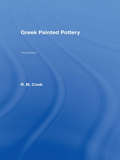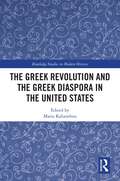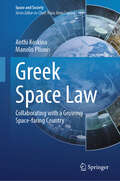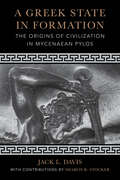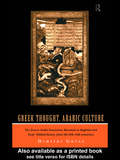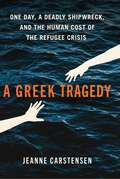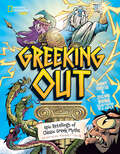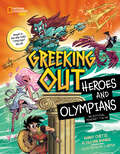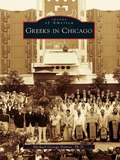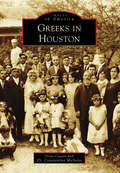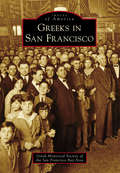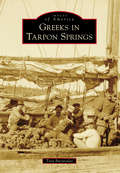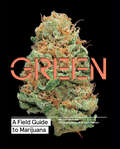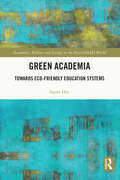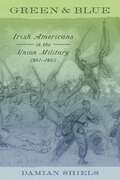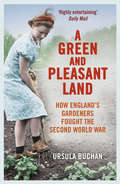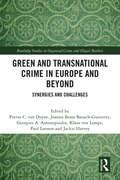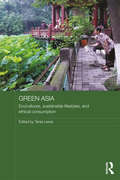- Table View
- List View
Greek Painted Pottery
by R M **Decd** R. M. CookGreek Painted Pottery has been used by classics and classical archaeology students for some thirty years. It thoroughly examines all painted pottery styles from the Protogeometric to the Hellenistic period from all areas of Greece and from the colonies in parts of Italy. In each case it covers the development of iconography and the use of colour, decorative motifs and the distinctive styles of each stage. It examines the most utilitarian pottery objects as well as some of the finest pieces produced by a flourishing civilisation. Other chapters cover the pottery industry and pottery-making techniques, including firing, the types of local clay which were used and inscription. This study also considers how one can date pottery and establish a chronology and the various methods by which these artefacts have been classified, preserved and collected.This is the third edition of this classic text, which has been extensively revised and includes a fully updated bibliography. This edition also includes coverage of new evidence and new theories which have surfaced since the book was last revised in 1972. With over 100 black and white photographs and plentiful line drawings, the new edition of this comprehensive text will be invaluable to students studying classical art, archaeology and art history.
The Greek Revolution and the Greek Diaspora in the United States (Routledge Studies in Modern History)
by Maria KaliambouThis book examines the question of historical awareness within the Greek communities in the diaspora, adding a new perspective on the discussion about the Greek Revolution of 1821 by including the forgotten Greeks in the United States and Canada. The purpose of this volume is to discuss the impact of the Greek Revolution as manifested in various discourses. It is celebrated by the Greek communities, taught in Greek schools, covered in the local newspapers. It is an inspiration for literary, artistic, and theatrical creations. The chapters reflect a broad range of disciplines (history, literature, art history, ethnology, and education), offering both historical and contemporary reflections. This volume produces new knowledge about the Greeks in the United States and Canada for the last 100 years. The Greek Revolution and the Greek Diaspora in the United States will attract scholars, students, and public readers of Modern Greek Studies and Greek American Studies, as well as those interested in comparative history, diaspora and ethnic studies, memory studies, and cultural studies.
Greek Space Law: Collaborating with a Growing Space-faring Country (Space and Society)
by Anthi Koskina Manolis PlionisThis book provides an overview of the Greek legislation applying to space activity under the responsibility of the Greek State, as in line with international space law. Greece is not an established space-faring country; however, it is showing particular dynamism, making the most of its participation in international and EU space endeavors. Indeed, along with outstanding achievements in space science Greece took legislative action both at the international and national levels (proposals at the UNCOPUOS; Greek space law; signing of the Artemis Accords). Hence, the time has come to refer to – and present aspects of – the Greek space legislation. After an introductory section, the book provides information first on the national laws providing for the Greek participation in international space systems and in EU activities, which could be regarded as being the initial steps of Greece in the context of space. Thereafter, the rules applying to Greek space activity per se are presented, focusing on the authorities competent to decide on space matters, then on the substantial law rules allowing for – and clarifying – the application of international space law to domestic space operations. This book presents an overall view and analysis of the Greek space legislation, adding valuable information to the existing bibliography. Included as an appendix is a scholarly translation of the 2017 Greek space law.
A Greek State in Formation: The Origins of Civilization in Mycenaean Pylos (Sather Classical Lectures #75)
by Jack L. DavisA free open access ebook is available upon publication. Learn more at www.luminosoa.org. Although the Mycenaean civilization of the Greek Bronze Age was identified 150 years ago, its origins remain obscure. Jack L. Davis, codirector of excavations at the Palace of Nestor at Pylos, takes readers on a tour of the beginnings of Mycenaean civilization through a case study of this important site. In collaboration with codirector Sharon R. Stocker, Davis demonstrates that this ancient place was a major node for the exchange of ideas between the already established Minoan civilization, centered on the island of Crete, and the residents of the Greek mainland. Davis and Stocker show how adoption of Minoan culture created an ideology of power focused on a single individual, celebrating his military prowess, investing him with divine authority, and creating a figure instantly recognizable to readers of Homer and students of Greek history. A Greek State in Formation makes the powerful case that a knowledge of the Greek Bronze Age is indispensable to the classics curriculum.
Greek Thought, Arabic Culture: The Graeco-Arabic Translation Movement in Baghdad and Early 'Abbasaid Society (2nd-4th/5th-10th c.)
by Dimitri GutasFrom the middle of the eighth century to the tenth century, almost all non-literary and non-historical secular Greek books, including such diverse topics as astrology, alchemy, physics, botany and medicine, that were not available throughout the eastern Byzantine Empire and the Near East, were translated into Arabic.Greek Thought, Arabic Culture explores the major social, political and ideological factors that occasioned the unprecedented translation movement from Greek into Arabic in Baghdad, the newly founded capital of the Arab dynasty of the 'Abbasids', during the first two centuries of their rule. Dimitri Gutas draws upon the preceding historical and philological scholarship in Greco-Arabic studies and the study of medieval translations of secular Greek works into Arabic and analyses the social and historical reasons for this phenomenon.Dimitri Gutas provides a stimulating, erudite and well-documented survey of this key movement in the transmission of ancient Greek culture to the Middle Ages.
A Greek Tragedy: One Day, a Deadly Shipwreck, and the Human Cost of the Refugee Crisis
by Jeanne CarstensenFive Days at Memorial meets Into the Raging Sea with this harrowing and moving true story of a devastating shipwreck during the biggest refugee crisis since World War II. On October 28, 2015, a boat meant for only a few dozen passengers capsized off the coast of the Greek island of Lesvos. Hundreds of refugees, forced in desperation onto the overloaded boat manned by armed smugglers, were tossed into a roiling sea. The resulting loss of life, the largest in a single day during the crisis in the Aegean, shocked the world. Now, after nearly a decade of research, interviews, and investigation, reporter Jeanne Carstensen has captured every detail of the dramatic twenty-four hours. This includes the recollections of the refugees&’ lives before they left their homes and a full account of the courageous rescue efforts of the Greek islanders and volunteers rushing to help, even as their government and the EU failed to act. In this remarkable narrative feat, Carstensen brilliantly showcases the extraordinary heroism of ordinary people in extreme circumstances. In a world where forced migration is on the rise, A Greek Tragedy challenges us to confront our collective humanity. It&’s an unforgettable testament of our times and a compassionate depiction of the lengths to which a person will go to save another human being.
Greek Vase-painting and the Origins of Visual Humour
by Alexandre G. MitchellA comprehensive study of visual humour in ancient Greece, with special emphasis on works created in Athens and Boeotia. Alexandre Mitchell brings an interdisciplinary approach to this topic, combining theories and methods of art history, archaeology, and classics with the anthropology of humour, and thereby establishing new ways of looking at art and visual humour in particular. Understanding what visual humour was to the ancients and how it functioned as a tool of social cohesion is only one facet of this study. Mitchell also focuses on the social truths that his study of humour unveils: democracy and freedom of expression, politics and religion, Greek vases and trends in fashion, market-driven production, proper and improper behaviour, popular versus elite culture, carnival in situ, and the place of women, foreigners, workers, and labourers within the Greek city.
Greeking Out: Epic Retellings of Classic Greek Myths (Greeking Out)
by Kenny CurtisFrom the creators of National Geographic Kids&’ wildly successful Greeking Out podcast, this New York Times best-selling tie-in book delivers a clever tongue-in-cheek retelling of 20 classic Greek myths.This kid-friendly collection of tales from Greek mythology showcases familiar favorites from the well-loved Greeking Out podcast as well as brand-new, never-before-aired stories. Join Persephone on her journey through the mystifying depths of the Underworld. Venture onwards with Heracles as he tackles his 12 death-defying labors. And join mythological figures you may not have heard of before, including scheming gods and goddesses, honorable—and not so honorable—heroes, and magnificent monsters.Dynamic, playful illustrations coupled with laugh-out-loud storytelling and real information about ancient Greece—delivered by the all-knowing Oracle of Wi-Fi—make this collection of fabulous fables a fresh addition to any history-lover's library.
Greeking Out Heroes and Olympians (Greeking Out)
by Kenny CurtisINSTANT NEW YORK TIMES BEST SELLER! Get ready for 20 brand-new, tongue-in-cheek tales from Greek mythology, as told by the team behind the smash hit podcast.Want to know the greatest feats and the funniest secrets of the gods and heroes of Greek mythology? You&’re in the right place. Told in the hilarious, kid-friendly voice that&’s sent the Greeking Out podcast to the top of the charts, these stories of heroic victories, perilous adventures, and plain old mischief are sure to delight kids and adults alike. Plus, fans of the Percy Jackson series will love discovering the real myths behind their favorite (and least favorite) characters.In this book, you&’ll encounter a god kidnapped by pirates, sheep used as camouflage, a super-shiny fleece, some dangerous metalworking, the world&’s most perfect animal, a really heavy boulder, and much more.Dynamic, playful illustrations coupled with laugh-out-loud storytelling and real information about ancient Greece—delivered by the all-knowing Oracle of Wi-Fi—make this collection of fabulous fables an essential addition to your library. Complete your collection with Greeking Out: Epic Retellings of Classic Greek Myths.
The Greeks: The Land and People Since the War
by James PettiferOur perception of Greece conjures up many potent images: an ancient civilization brought alive by fable, hillsides dotted with sunbaked villages, lazy beaches lapped by crystal blue waters, the warmth and humour of its people. Yet if we look behind the picture-postcard imagery, the painful contradictions of the country begin to emerge. James Pettifer's classic text on Greece, now revised and updated with extensive new material, argues that it is vital to understand this country's present by looking at the far-reaching effects of its troubled past. He surveys the roots of Greek social, economic and political realities with intelligence and convincing clarity.
The Greeks and the New
by Armand D'AngourThe Greeks have long been regarded as innovators across a wide range of fields in literature, culture, philosophy, politics and science. However, little attention has been paid to how they thought and felt about novelty and innovation itself, and to relating this to the forces of traditionalism and conservatism which were also present across all the various societies within ancient Greece. What inspired the Greeks to embark on their unique and enduring innovations? How did they think and feel about the new? This book represents the first serious attempt to address these issues, and deals with the phenomenon across all periods and areas of classical Greek history and thought. Each chapter concentrates on a different area of culture or thought, while the book as a whole argues that much of the impulse towards innovation came from the life of the polis which provided its setting.
Greeks in Chicago
by Ph.D., Michael DavrosGreeks arrived in America with the expectation that freedom would permit their families to thrive and be successful. With hard work, belief in the Orthodox faith, and commitment to education, Greeks ascended in Chicago, and America, to positions of responsibility and success. Today Greek Americans are among the wealthiest and most successful of immigrant groups. Greeks recognized a historical imperative that they meet the challenges and aspirations of a classical Hellenic heritage. Greeks in Chicago celebrates the rich history of the Greek community through copious pictorial documentation.
Greeks in Houston
by Irene Cassis Constantina MichalosThis history of the Greeks in Houston is really the story of individuals who worked diligently to forge new lives for themselves even as they maintained their Greek identity and their Orthodox faith. The efforts of many of the founders are immortalized in the buildings that constitute the Annunciation Greek Orthodox Cathedral complex. Their names remind us of their hard work and commitment to establishing their koinonia (communion) in Houston. There are many other names that have gone unremarked over the decades but to whom we owe just as much for their tenacity and dedication. And there are the new generations who inherited this legacy and keep it vibrant through the stewardship of their faith and culture.
Greeks in San Francisco (Images of America)
by Greek Historical Society of the San Francisco BayThe history of San Francisco's Greek community is linked to the history of San Francisco. The first Greeks to arrive were sailors, miners, and laborers. By the 1880s, they had formed benevolent, civic, and fraternal organizations. In 1904, the first Greek Orthodox Church west of Chicago was established, and Third Street became the heart of the Greek community. The 1906 earthquake and fire destroyed much of their new community, but undaunted, the Greeks of San Francisco rebuilt their lives to become business leaders and politicians, contributing their entrepreneurial and philanthropic spirit to the city's rich heritage.
Greeks in Tarpon Springs (Images of America)
by Tina BucuvalasBeginning in 1905, large numbers of Greeks from the Dodecanese and Saronic Gulf islands settled in Tarpon Springs to work in the sponge business. They significantly expanded the industry and changed Tarpon Springs forever. Greektown flourished with residences, stores, churches, restaurants, and recreational facilities stretching from the sponge docks to downtown. Sponge fishing and related activities served as the economic base for the community. By 1913, as many as half of Tarpon Springs residents were reputedly Greek, and many businesses displayed both Greek and American flags. Today, Tarpon Springs' Greek community preserves a strong ethnic and maritime heritage. While some major US cities have a larger Greek population, no other has a greater percentage with Greek heritage than Tarpon Springs.
Greeks of Stark County
by Regine Johnson Samonides William H. SamonidesBy the early 20th century, Stark County was one of the fastest-growing regions in the nation. The home of martyred president William McKinley had become a major industrial center, with alloy steel as the engine of growth for the booming local economy. To fill the ever-increasing demand for labor, waves of immigrants from Greece and Asia Minor settled in Canton and Massillon. Some sought economic opportunity; others were fleeing the Pontian Black Sea coast, where ethnic cleansing of Greeks accompanied the creation of the Turkish state. For the immigrant earning less than $3 a day, building a church meant making a commitment to a new life. In Canton, St. Haralambos Greek Orthodox Church was founded in 1913 and Holy Trinity Greek Orthodox Church in 1917. In Massillon, St. George Greek Orthodox Church was established in 1931. Churches and mutual aid organizations provided cohesiveness to the dynamic, often fractious, Greek community, which survived world wars, economic depression, and social discrimination and continues to flourish today.
Greeks of the Merrimack Valley (Images of America)
by E. Philip Brown Elaine KevgasThe Merrimack Valley became home to Greeks after the great immigration to the United States in the 19th and 20th centuries. After its independence from the Ottoman Empire in 1832, Greece had inadequate resources for its citizens, which led to much hardship. Many of these refugees came to the Merrimack Valley in search of a better living. They settled in Haverhill, Lawrence, and Lowell, Massachusetts, or Concord, Manchester, and Nashua, New Hampshire, where they secured jobs in factories and mills. Those who were unable to gain employment in the manufacturing industries went into the service sector; others became self-sufficient, building restaurants, shoe shops, and grocery stores. Although they suffered discrimination because of their distinct language and culture, they were not deterred; instead, they remained focused, went about their activities in peace, and contributed immensely to the socioeconomic development of their newfound home.
Green: A Field Guide to Marijuana
by Dan Michaels ChristiansenGreen: A Field Guide to Marijuana is required reading for a new generation of curious and sophisticated pot smokers. Presented in an eye-popping package and filled with hyperdetailed photography of individual buds, this essential guide to marijuana is smart, practical, and exceedingly beautiful. The "Primer" section explores the culture of this complex flower and explains the botany that makes each strain unique. The "Buds" section describes the variations of lineage, flavor, and mental or physical high that define 170 exceptional strains. Poised to become the go-to marijuana guide for recreational and medicinal users alike, Green is easy to pick up and impossible to put down.
Green Academia: Towards Eco-Friendly Education Systems (Academics, Politics and Society in the Post-Covid World)
by Sayan DeyThis book studies the importance of adopting Green Academia as a systemic long-term counter-intervention strategy against any form of impending pandemics in the post-COVID era and beyond. It argues that anti-nature and capitalistic knowledge systems have contributed to the evolution and growth of COVID-19 across the globe and emphasizes the merits of reinstating nature-based and environment-friendly pedagogical and curricular infrastructures in mainstream educational institutions. The volume also explores possible ways of weaving ecology and the environment as a habitual practice of teaching and learning in an intersectional manner with Science and Technology Studies. With detailed case studies of the green schools in Bhutan and similar practices in India, Kenya, and New Zealand, the book argues for different forms of eco-friendly education systems and the possibilities of expanding these local practices to a global stage. Part of the Academics, Politics and Society in the Post-COVID World series, this book will be an essential read for scholars and researchers of sociology, cultural studies, decolonial studies, education, ecology, public policy social anthropology, sustainable development, sociology of education, and political sociology.
Green Accounting (International Library Of Enviromental And Policy Economics Ser.)
by Peter Bartelmus and Eberhard K. SeifertThis title was first published in 2003. Our cherished economic indicators of income, product, consumption and capital fail in taking a long-term view of social progress. They do not account for environmental deterioration, which impairs the quality of life of present and future generations, and hence the sustainability of development. "Greening" the conventional national (and corporate) accounts introduces environmental impacts and costs into these accounts and balances. The result is a new compass for steering the economy towards sustainability, which may change not only our main measures of economic performance but also the basic tenets of environmental and resource policies. This book presents methodological advances and case studies of environmental accounting, and discusses their use in environmental management and policies. In their introduction, the editors provide a critical perspective of historical developments and current debates.
Green and Blue: Irish Americans in the Union Military, 1861–1865 (Conflicting Worlds: New Dimensions of the American Civil War)
by Damian ShielsDamian Shiels’s Green and Blue explores Irish American service in the United States military by analyzing the written correspondence of ordinary rank-and-file soldiers drawn from across the Union’s armed forces. Using a vast and largely untapped collection of letters penned by Irish American combatants to their families during the war, Shiels explains how these enlisted men navigated their duties from multiple perspectives, including how they adapted to and experienced military life, how they engaged with their faith, and how they interacted with the home front. Green and Blue offers the most detailed and intimate picture yet of Irish Americans’ service in the United States military during the Civil War.
A Green and Pleasant Land: How England’s Gardeners Fought the Second World War
by Ursula BuchanSHORTLISTED FOR INSPIRATIONAL BOOK OF THE YEAR AT THE 2014 GARDEN MEDIA GUILD AWARDS. The wonderfully evocative story of how Britain’s World War Two gardeners – with great ingenuity, invincible good humour and extraordinary fortitude – dug for victory on home turf.A Green and Pleasant Land tells the intriguing and inspiring story of how Britain's wartime government encouraged and cajoled its citizens to grow their own fruit and vegetables. As the Second World War began in earnest and a whole nation listened to wireless broadcasts, dug holes for Anderson shelters, counted their coupons and made do and mended, so too were they instructed to ‘Dig for Victory’. Ordinary people, as well as gardening experts, rose to the challenge: gardens, scrubland, allotments and even public parks were soon helping to feed a nation deprived of fresh produce. As Ursula Buchan reveals, this practical contribution to the Home Front was tackled with thrifty ingenuity, grumbling humour and extraordinary fortitude. The simple act of turning over soil and tending new plants became important psychologically for a population under constant threat of bombing and even invasion. Gardening reminded people that their country and its more innocent and insular pursuits were worth fighting for. Gardening in wartime Britain was a part of the fight for freedom.
Green and Transnational Crime in Europe and Beyond: Synergies and Challenges (Routledge Studies in Organised Crime)
by van Duyne, Petrus C. Joanna Banach-Gutierrez Georgios A. Antonopoulos Klaus Von Lampe Paul Larsson Jackie HarveyThis book brings together research and studies in the fields of organised crime and of ‘green criminality’ against the natural environment. By bringing the research traditions of organised crime and ‘green criminology’ into closer proximity and combining contributions on traditional organised crime and ecological crime in one volume, it questions the need to draw artificial dividing lines between criminological sub-disciplines. Including chapters on the illegal trade in cobalt, in stolen motor vehicles, the illegal dog market, cross- border amber trafficking, deforestation and environmental harm in the Norwegian industrial salmon farming, the book offers an important rapprochement between studies in organised crime and green criminology, and considers the operational differences between underworld and upperworld criminal economies.
Green Approaches in Building Design and Management Practices: Windows of Opportunity Towards Circularity (Digital Innovations in Architecture, Engineering and Construction)
by Nazly AttaThis book examines green transition and circular economy in the fields of building design and Real Estate management. By outlining windows for seizing the opportunity to integrate circular approaches in current building practices, the book provides information tools to support building stakeholders (e.g. building designer and managers, manufacturers, Real Estate owners, maintenance operators, facility managers, etc.) in: (i) understanding circular re-strategies (e.g. reuse, remanufacturing, repurposing, etc.), the related requirements and the pre-conditions for their implementation within building design and management practices; (ii) reviewing design approaches at the product and building scale, also highlighting new circularity-related contents for the Briefing Documents; (iii) developing circular organizational and contract models for the procurement of Facility Management services, also integrating new circularity-related contents in Invitations to Tenders (ITTs); and (iv) assessing the quality and the effectiveness of circular practices, also highlighting circularity performance metrics and indicators in the context of corporate sustainability reporting.
Green Asia: Ecocultures, Sustainable Lifestyles, and Ethical Consumption (Media, Culture and Social Change in Asia)
by Tania LewisEconomic development in Asia is associated with expanding urbanism, overconsumption, and a steep growth in living standards. At the same time, rapid urbanisation, changing class consciousness, and a new rural–urban divide in the region have led to fundamental shifts in the way ecological concerns are articulated politically and culturally. Moreover, these changes are often viewed through a Western moralistic lens, which at the same time applauds Asia’s economic growth as the welcome reviver of a floundering world economy and simultaneously condemns this growth as encouraging hyperconsumerism and a rupture with more natural ways of living. This book presents an analysis of a range of practices and activities from across Asia that demonstrate that people in Asia are alert to ecological concerns, that they are taking action to implement new styles of green living, and that Asia offers interesting alternatives to narrow Anglo-American models of sustainable living. Subjects explored include eco-tourism in the Philippines, green co-operatives in Korea, the importance of "tradition" within Asian discourses of sustainability, and much more.
